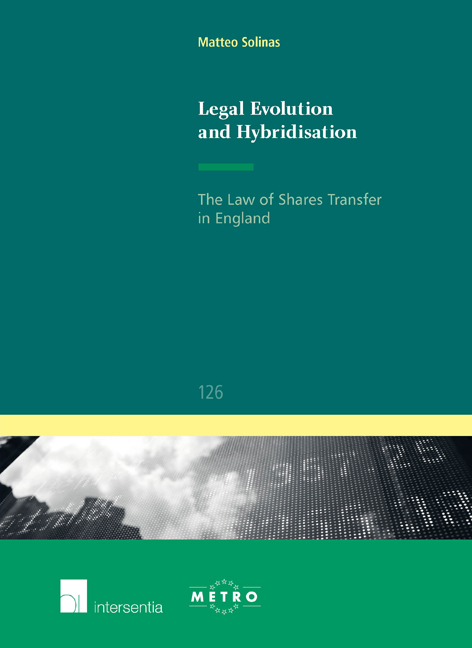Book contents
- Frontmatter
- Foreword
- Preface
- Acknowledgements
- Contents
- Table of Cases
- Introduction
- PART I THE IDEA OF HYBRIDITY IN COMPARATIVE LAW
- PART II THE CIRCULATION OF SHARES
- Introduction to Part II
- Chapter 4 The Transfer of Registered Shares
- Chapter 5 The Transfer of Share Warrants to Bearer
- Summary of Part II
- PART III THE TRANSFER OF (INTERESTS IN) SHARES
- Summary of Part III
- Conclusions
- Bibliography
- IUS COMMUNE EUROPAEUM
Summary of Part II
from PART II - THE CIRCULATION OF SHARES
Published online by Cambridge University Press: 22 November 2017
- Frontmatter
- Foreword
- Preface
- Acknowledgements
- Contents
- Table of Cases
- Introduction
- PART I THE IDEA OF HYBRIDITY IN COMPARATIVE LAW
- PART II THE CIRCULATION OF SHARES
- Introduction to Part II
- Chapter 4 The Transfer of Registered Shares
- Chapter 5 The Transfer of Share Warrants to Bearer
- Summary of Part II
- PART III THE TRANSFER OF (INTERESTS IN) SHARES
- Summary of Part III
- Conclusions
- Bibliography
- IUS COMMUNE EUROPAEUM
Summary
Part II investigated the historical evolution of the mechanisms by which shares in English companies are transferred. In line with the themes presented in Part I, it redefi ned Watson's thesis on legal transplants with arguments on cultural interaction originated in the postcolonial debate. More precisely, it suggested that contrary to the conventional interpretation, the original form of the joint stock company and its structural elements of association were not a spontaneous indigenous creation. They were borrowed from abroad and progressively integrated through a process of hybridisation in the preexisting English legal framework starting from the sixteenth century with the growth of international trade.
The inquiry distinguished between the transfer of registered shares and share warrants to bearer. Although they both enjoy the same economic function of units of the corporate capital, they are nevertheless different in terms of legal nature, regulation and modes of circulation. The explanation is historical.
Chapter 4 examined registered shares. Section 1 identified the subject matter of the inquiry by describing where the law currently stands. It found that a share today is a bundle of contractual rights with certain unique proprietary characteristics and that the certificate (capable of possession) in the case of registered shares is not evidence of legal title. Legal title passes upon the entry of the transferee into the register of members according to a tripartite scheme of transfer akin to novation. Section 2 focused on the modes of circulation of registered shares from an historical perspective. Building on the legal framework outlined in section 1, it set out the links between the growth of the legal tradition and the present characterisation. The analysis on the concept of incorporation, in particular, suggested that the historical connections between the development of the partnership model and the evolution of the company form were very strong at least until the enactment of the Joint Stock Companies Act of 1844. The discussion on the mechanism of transfer of legal title to shares, both for incorporated and unincorporated companies, supported this view, evidencing among other things, the similarities with the current legal characterisation based on novation.
- Type
- Chapter
- Information
- Legal Evolution and Hybridisation , pp. 133 - 136Publisher: IntersentiaPrint publication year: 2014



